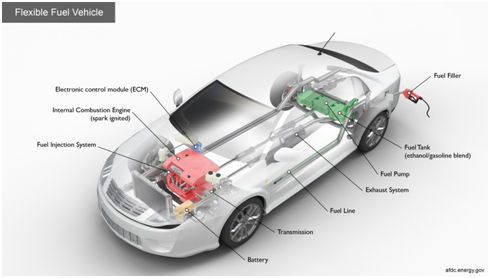

Context
India is going to get its first flex-fuel car by Toyota, which can run both on ethanol-blended petrol and a battery.
About
Need of the initiative
- According to the Union Ministry of Road Transport and Highways, the push to encourage car manufacturers to use flexible engines is part of a larger strategy to reduce the country's reliance on imported crude oil in the medium to long term.
- Since ethanol blending is expected to reach 20% by 2025-26, the groundwork will be laid for the introduction of FFV-SHEV vehicles in India.

The Flex-fuel Technology:
- The Flex Fuel Strong Hybrid Electric Vehicle (FFV-SHEV)imported from Brazil will be used in a pilot project led by the Government of India to evaluate its performance in terms of reduced carbon emissions and reducing the country's reliance on imported fossil fuels.
- A flex or flexible fuel vehicle has an internal combustion engine (ICE), but unlike a traditional petrol or diesel vehicle, it can run on more than one type of fuel, or even a combination of fuels.
- The most common versions use a blend of petrol and ethanol or methanol, but these engines can also run on 100% petrol or
- This is accomplished by equipping the engine with a fuel mix sensor and engine control module (ECM) programming that detects and adjusts for any ratio of designated fuels.
Analysis
What makes Flex Fuel cars different from petrol cars?
- The FFVs contain mainly an internal combustion engine and can operate on petrol or its blend with ethanol up to 83%.
- There are modifications done to the fuel pump and fuel injection system.
- To accommodate the higher oxygen content of ethanol, FFVs are also calibrated with Engine Control Module.
Significance of the initiative
- The initiative will power India's aim to be among the top global producers in every segment of vehicles over the next 25 years, as stated by Society of Indian Automobile Manufacturers (SIAM).
- It monitors and controls the fuel mixture, ignition timing, and emissions system.
- It is also responsible for detecting and troubleshoots problems.
Advantages
- They will have a wider option of fuels that may shield them from highly volatile fuel prices.
- It will also help India in reducing its dependence on fuel imports.
- Less pollution and more durable option for customers.
- It can grow as a sustainable means to conserve our natural resources.
Disadvantages
- Less efficient than petrol fuel: When using ethanol, a flex fuel vehicle typically loses 4-8% of its fuel efficiency.
- While increased levels of ethanol reduce fuel economy, many flex fuel vehicles improve acceleration performance when operating on higher ethanol blends.
- Dependence on single crop/source: According to an NITI Aayog report, sugarcane accounted for more than 90% of total ethanol produced in the country in 2019-20.
- Can lead to exploitation of resources: A major issue with ethanol blending is that crops like sugarcane require a lot of water in a country with scarce fresh water resources.

